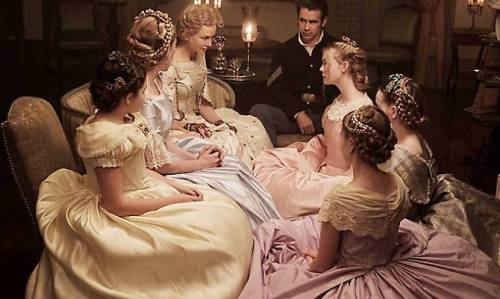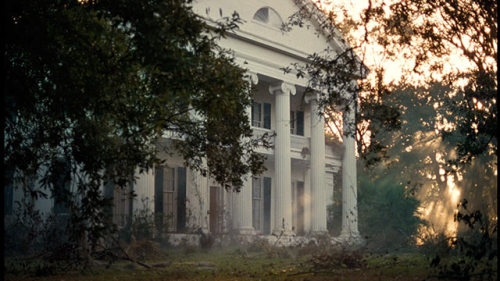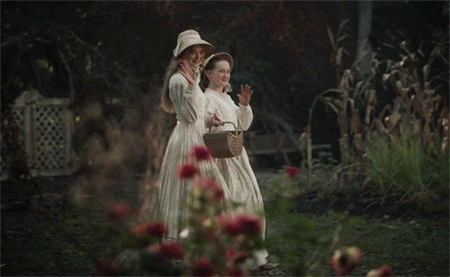
"THE BEGUILED" (2017) Review
I have never been a diehard fan of Southern Gothic fiction. Not really. But there have been some fictional works in that genre that have appealed to me. In fact, if you ask me, I could come up with a pretty good list of Southern Gothic movie and television productions that I have always enjoyed.
Thomas Cullinan's 1966 novel, "The Beguiled" aka "A Painted Devil" first came to my attention when I saw the 1971 movie adaptation of the novel years ago. I became an instant fan of the film and read Cullinan's novel. Then I became a fan of the novel. So when I heard that director Sofia Coppola planned to direct her own film adaptation, I looked forward to it. One, I liked the story. Two, I am a sucker for a good Civil War film, being an amateur historian and movie nut. And I had also learned Coppola had won the Palme d'Or Best Director award (the second woman to do so) at the 2017 Cannes Film Festival for this film.
Don Siegel's 1971 adaptation had made a few changes to Cullinan's novel. One, he and the movie's screenwriters made the story's leading man an American of Irish descent, instead of the Irish immigrant portrayed in the novel. The story was set in 1863 Mississippi, during the Vicksburg Campaign. And two of the novels' characters - the 17 year-old biracial Edwina Morrow and the nearly middle-aged Miss Harriet Farnsworth - were merged into a young white schoolteacher named Edwina Dabney. Sofia Coppola's movie maintained the novel's portrayal of leading man as an Irish immigrant and Cullinan's setting - 1864 Virginia, during the Civil War's Overland Campaign. However, Coppola's movie followed Siegel's example by merging the Edwina Morrow and Harriet Farnsworth characters into a schoolteacher.
"THE BEGUILED" began in the woods, near the Farnsworth Seminary, an all girls' school in 1864 Virginia. When one of its students, a thirteen year-old girl named Amy is searching the woods for mushrooms to pick, she comes across a wounded Union Army soldier named Corporal John McBurney. He had been wounded in the leg before deserting the battlefield. Amy brings McBurney to the school where he falls unconscious. The school's headmistress, Miss Martha Farnsworth, decides to heal the corporal's wounded leg before turning him over to the Confederate Army as a prisoner. But Miss Farnsworth, Amy and the other females inside the school become "charmed" by the Irish-born soldier, as he slowly heals from his wounds. Amy, another student named Alicia and the school's remaining teacher, Edwina Morrow, become especially captivated by McBurney's charm. However, McBurney's presence in the school generate a good deal of jealousy between the young students and the two women before an unexpected incident spirals the entire situation out of control.
Like the 1966 novel and its 1971 adaptation, "THE BEGUILED" took me by surprise in many ways. One of the film's most noteworthy aspects was Philippe Le Sourd's cinematography. I have never seen any of his previous film work. But I must admit that his photography did an excellent job in creating this film's Old South atmosphere:

Le Sourd's cinematography definitely helped setting up the film's atmosphere, especially due to the lack of any solid score. I also have to give points to Stacey Battat for creating costumes designs indicative to the Civil War period - especially for women and girls. Mind you, I thought some of the costumes may have been slightly anachronistic.
I also cannot deny that "THE BEGUILED" featured some strong performances from the cast. Nicole Kidman, Colin Farrell and Kirsten Dunst were top-notched, as usual. Kidman did a fine job portraying the no-nonsense and pragmatic headmistress, Martha Farnsworth, who seemed to have little problems with controlling those around her . . . including her only schoolteacher. Despite Martha Farnsworth being her second role as a Southerner (I think), I was surprised that Kidman's Southern accent wavered a bit. Although Farrell is at least twenty years older than the literary John McBurney, he was free to portray the character as was described in Cullinan's novel - an Irish immigrant recently recruited into the Union Army upon his arrival in the United States. However, his McBurney's charm seemed to have more of an edge of desperation, due to his circumstances. And Kirsten Dunst gave a very competent performance as the emotionally repressed Edwina Morrow, a young schoolteacher who finds herself drawn to the handsome McBurney, despite her efforts to ignore him. Dunst also did a competent job in not only conveying Edwina's growing attraction to McBurney, but also her wariness of being under Miss Farnsworth's control.
The movie could also boast some surprisingly excellent performances from the younger cast members, who portrayed the school's students. Elle Fanning gave a decent performance as the adolescent Alicia, whose attraction to McBurney partly stems from her growing awareness of her sexuality. However, there were moments when it seemed she was losing some control of the character. Oona Laurence, Angourie Rice, and Emma Howard also gave very competent performances. But I was especially impressed by Addison Riecke's portrayal of young Marie, an impish student who borrowed Edwina's earrings for the dinner party with McBurney and managed to manipulatively avoid returning them to the schoolteacher. Excellent performance by the young actress.
Although "THE BEGUILED" possessed some admirable traits, overall I was not that impressed by the film. Frankly, I am at a loss over how Coppola managed to win such a prestigious award at the Cannes Film Festival. Perhaps the voters had no idea that the narrative for this film is basically a Southern Gothic tale? Who knows? Coppola had erased so much from Cullinan's story.
One aspect of "THE BEGUILED" that came to my attention was the lack of background for most of the characters at the Farnsworth Seminary. Now, unless my memory is failing me, the movie only revealed the fact that Edwina Morrow had a father living in Richmond. I believe the movie also touched upon the wartime fate of Amelia's brothers. I believe. To be honest, I am not that certain. Coppola deleted Martha Farnsworth's family history - especially her incestuous relationship with her brother. After all, one of the reasons Miss Farnsworth eventually opened up to McBurney was his resemblance to this "much loved" brother. Although the film revealed the existence of Edwina's father, the screenplay never touched upon his role as a war profiteer or his lack of concern toward his daughter. The movie revealed nothing about Alicia's family background - especially her prostitute mother who had abandoned her at the seminary. The movie revealed nothing about the remaining students' backgrounds. McBurney's discoveries and knowledge of their personal histories played a role in the events that occurred in the movie's third act. Without the revelations of the female characters' backgrounds, Coppola resorted to whitewashing the reasons behind their actions in the film's third act.
Coppola claimed that she wanted "THE BEGUILED" to give a "voice" to the story's female characters. Why did she make that claim? Each chapter in Cullinan's 1966 novel was written from the viewpoints of a major female character and NOT . . . from Corporal McBurney's point of view. Although the 1971 film featured scenes from McBurney's point of view, it also did the same for the female characters. Also, McBurney was the only major character who lacked an inner monologue. Since the novel and the 1971 film featured the females' points of view, what on earth was Coppola's goal? To portray her female characters as ideal as possible? I noticed that neither anger or jealousy played a role in the violence that marked the film's third act.
Alicia slept with McBurney because she was an adolescent "exploring her growing sexuality". Not once did Coppola's screenplay hint how her past experiences with her prostitute mother may have influenced her behavior with the opposite sex. By removing Martha Farnsworth's incestuous history with her late brother - the one whom McBurney resembled, Coppola removed any possibility of Miss Farnsworth being driven by anger and jealousy over his tryst with Alicia to amputate his leg. By having McBurney behave like a borderline stalker in one scene following his amputation, Coppola justified the females' decision to kill him with poisonous mushrooms. It seemed as if Coppola's idea of feminist sensibilities is to portray her female characters with as little flaws as possible. And this led to her portraying the female characters' decisions in the film's last hour to be marred by a lack of moral ambiguity of any kind. This decision on Coppola's part strikes me as cowardly.
If Coppola's decision to portray her females characters with as little ambiguity as possible was bad enough, she also eliminated the school's remaining slave, an African-American woman named Matilda ("Mattie"). Coppola gave a reason for this decision in the following statement:
"I didn’t want to brush over such an important topic in a light way. Young girls watch my films and this was not the depiction of an African-American character I would want to show them."
What depiction was she referring to? Cullinan's portrayal of Mattie in the 1966 novel? The only character who saw through McBurney's charming bullshit and wanted nothing to do with him? Or Hallie (who was renamed) from the 1971 film, who also saw through his charm, despite their occasional bouts of flirting. I had no problems with either Cullinan or Siegel's depictions of the character. Naturally, some movie reviewers supported Coppola's decision, including one reviewer from the ALLIANCE OF WOMEN FILM JOURNALIST, who stated:
"The film has been criticized for its lack of comment on the Civil War or slavery. The war is a backdrop, the circumstance that isolated than part of the story. Unlike the 1966 novel and the 1971 movie, there are no African American characters in this film, explained by a single line says they left. Because it is set in the Civil War, it is a valid point but addressing the issue would have taken the focus off the women’s issues that are Coppola’s main point."
Apparently, Coppola and her supporters do not regard women of color as a part of "women's issues". Or perhaps they feel that non-white women are not . . . women. White feminism at its height. If Coppola felt uncomfortable at the idea in exploring a non-white character, why on earth did she adapt Cullinan's novel in the first place?
The lack of Mattie/Hallie in Coppola's adaptation raised other problems. One, the slave woman's presence allowed both Cullinan and Siegel to portray the school's other occupants with a level of ambiguity that Coppola lacked the guts to face. I wonder if Mattie's presence would have robbed Coppola the opportunity to explore her fantasies regarding Southern white women. Mattie was one of two characters who knew why Martha Farnsworth was willing to amputate McBurney's leg in the novel. In Don Siegel's movie, she was the only one. This knowledge led to an interesting scene between the two women in both the novel and the 1971 film. In both the novel and the Siegel film, Mattie/Hallie was the person who actually prepared the poisoned mushrooms for McBurney . . . and she did it out of her own anger toward the Union soldier. Without the slave woman, who prepared the mushrooms in this film? Edwina Morrow, who had been serving as the establishment's cook, following the slaves' departure? At the time, she was busy enjoying lustful relations with McBurney. Miss Farnsworth? Did she know how to cook? The movie never established this.
"BEGUILED" did feature scenes of the students and the two teachers engaged in household and garden duties. First of all, none of them looked as if they knew what they were doing. Second of all, since they were such abysmal housekeepers, how did they managed to keep their clothing looking so pristine? Without the benefit of servants?

Judging from the costumes worn in the above image, Dunst and her younger co-stars do not look as if they are dressed for household duties. Instead, they seemed to be dressed for Sunday church services in the mid 19th century, an afternoon tea party or a picnic. At least other Civil War movie and television productions have their Southern female characters dressed more realistically . . . even the 1939 movie, "GONE WITH THE WIND". I find it difficult to believe that Miss Farnsworth and her fellow inhabitants were capable of keeping their daily clothes looking so pristine - with or without a servant. All of the look like figures in some Southern belle fantasy.
For me, there were other problems in Coppola's adaptation. I had a problem with her characterization of McBurney. Both the novel and the 1971 presented the character as something of a snake-tongued charmer. Farrell's interpretation seemed to present McBurney more as an obsequious man who resorts to slavish politeness, instead of charm, to win over the school's inhabitants. Farrell had the skill to convey McBurney's charm, but it seemed as if Coppola had somehow held him back. Worse, the movie barely touched upon the Civil War, despite the presence of a Union soldier. I also did not understand why Coppola maintained the character of Emily Stevenson, and yet transferred Emily's "pro-Confederate" personality to a character created for the film. Why did she do that? Why did she film this movie in Louisiana? Coppola retained the setting from the novel - Virginia 1864. Yet, she shot the film in the Deep South - a region that looked nothing like Virginia. Coppola could have changed the setting to the Deep South or shoot the film in the Upper South. She did neither. I also need to rephrase my comments regarding Philippe Le Sourd's cinematography. Although I admired his exterior shots in the film, I cannot say the same about his interior shots. Quite frankly, I could barely see a damn thing, even when a scene was set during the daytime.
I am still at a loss on how Sofia Coppola thought she could improve both Thomas Cullinan's novel and Don Siegel's 1971 adaptation. Granted, the cast - including Nicole Kidman, Colin Farrell and Kirsten Dunst - gave competent performances. But Coppola stripped away so much from this story. She stripped away a lot of the characters' ambiguity. She stripped away an important character who had the misfortune - at least in the director's eyes - to be an African-American. Which meant that she stripped away the topic of slavery and to a certain extent, even the war itself. In the end, "THE BEGUILED" seemed like a Southern Gothic tale with barely any life. It struck me as a shell of Cullinan's novel and Siegel's own adaptation. After watching this film, I found myself asking why Coppola felt she could adapt the 1966 novel in the first place, considering that she seemed incapable of exploring it with any semblance of real honesty.
















































